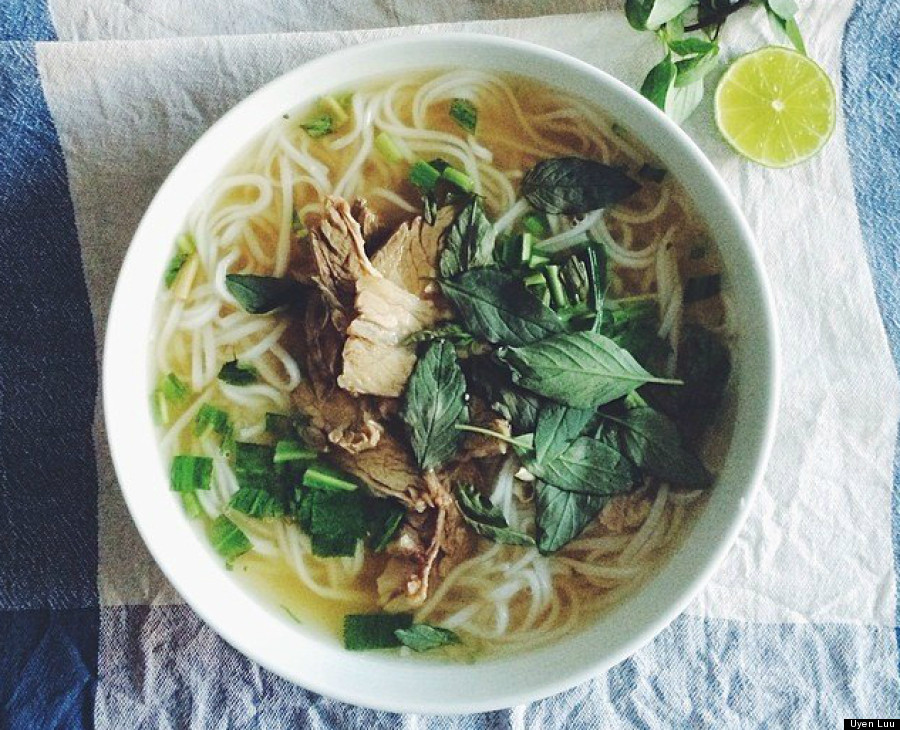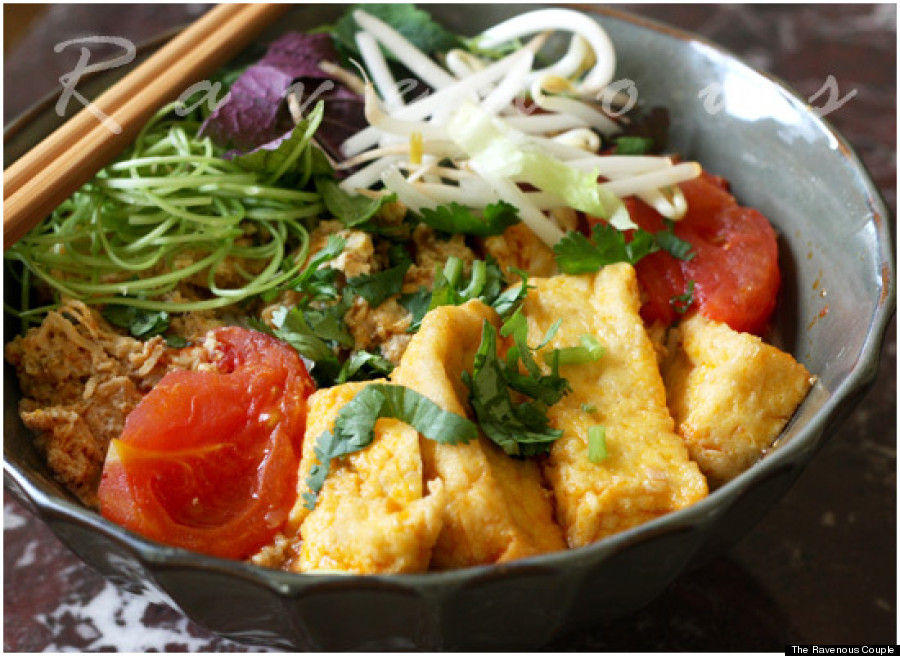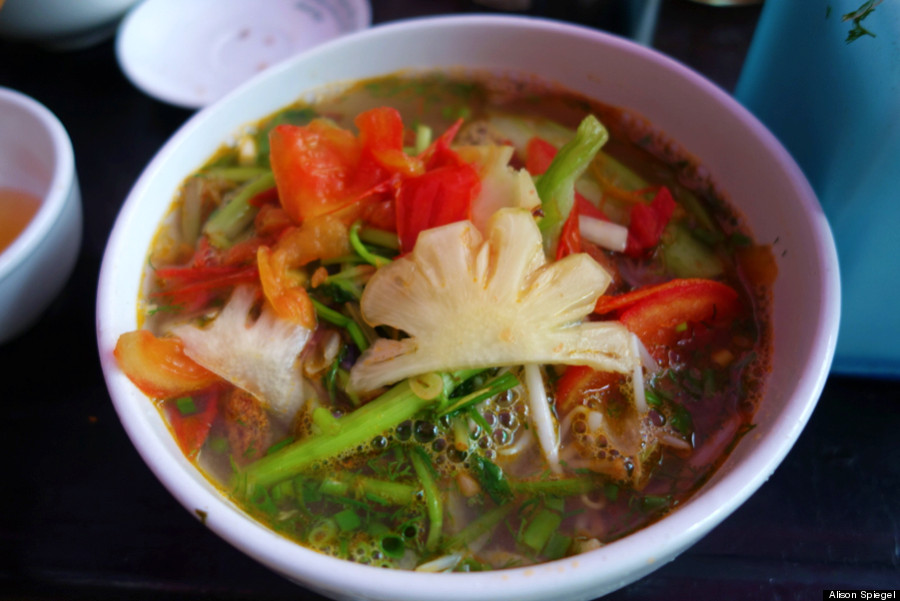
Turning left at what we thought was a dead end in Hanoi's Old Quarter, we hesitantly inched down Ngõ Trung Yên road, wide-eyed and excited, but with little idea of what to expect. We didn't know what we were looking for save that it was a food stall under a banyan tree, next to the entrance of a temple -- directions we garnered from a food blog on Vietnamese street food. My husband and I had arrived in Hanoi, Vietnam's capital, a mere two hours earlier, and we were already on the hunt for some of the city's famed street food.
Our first mission was to find a street food Hanoi is known for: Bún chả, which is grilled pork served on top of vermicelli noodles. When we spotted the banyan tree and the words "bún cá" (note: not chả) written on the wall behind a set of mini tables, we knew we were in the right place. We just didn't realize yet we were there for the wrong dish.
Speaking not a lick of Vietnamese, we sat down on a pair of blue plastic stools and smiled at the man tending to a large, steel stock pot in the corner. With no way to communicate what we were looking for or what we hoped to order, we just kept smiling. Luckily, with four options on the menu -- which consisted of the writing on the wall behind us -- little communication was needed to convey that we wanted two orders of whatever he wanted to give us. From what we could see in the open kitchen by our side and on the plates of the people around us, there were only two items being served at that moment, and neither one of them was grilled pork on vermicelli noodles. As the man served us a plate of what looked like fried spring rolls, followed by two steaming bowls of soup, it became clear we weren't going to be eating Bún chả. The irresistible aroma of fried pork, beautiful vegetables in our soup bowls and heaping pile of herbs on our garnish plate made the realization an easy one to stomach. We dug in, happily.
Knowing not what we were eating, we tried to decipher the savory, complex, enchanting flavors that were overwhelming our senses. Dill, fresh tomatoes and scallions swam in a broth studded with hunks of fish and fried something else. Was it also fish? The meat tasted minced. Was it the same minced meat in the fried spring rolls on the communal plate between us? We couldn't be sure, but it didn't matter much. It wasn't quite noon and while the heat of the day was overpowering, all we could think about was how amazing the food tasted.
Crouching on tiny plastic stools in a back alley of Hanoi's Old Quarter, dripping with sweat in the scorching heat, shaded only by a thick tangle of telephone wires overhead, we blissfully slurped our unidentified Vietnamese soup. It is a moment I'll never forget -- and a meal that will live on in my mind as one of life's greatest.
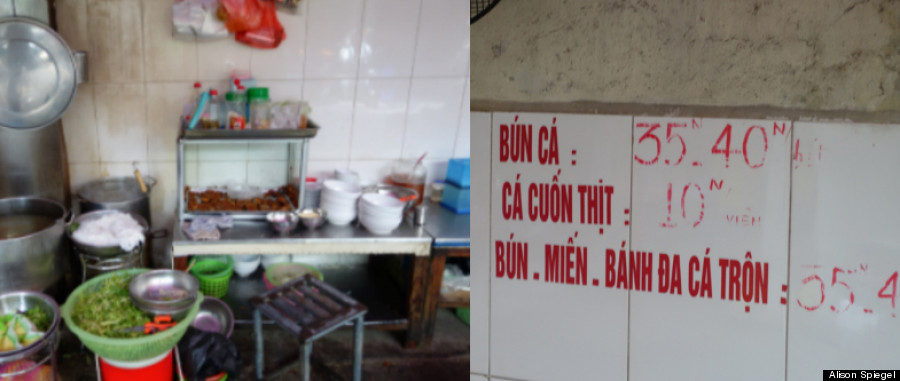

Only as we got up to leave did we realize the dish listed on the wall that we thought was called Bún chả was really "bún ca" -- notice the omission of the "h" in "chả." Completely unfamiliar with the Vietnamese alphabet, the missing letter on the wall had eluded us entirely until that moment. We literally failed to read the writing on the wall. It turns out that in all the reading I had done on various food blogs, I had gotten confused and ended up dragging my husband to a soup stand in search of barbecued pork. By the time we returned to an Internet connection hours later, the spicy and slightly sweet flavors of the soup, the meaty fried minced pork and burst of herbs on the garnish plate were still fresh in our minds. We immediately revisited the food blog that had led us to that back alley to discover what bún cá really was.
Bún cá is a fish soup with roots in the city of Nha Trang on the South Central coast of Vietnam. The broth might be pork, chicken or fish-based, and is poured on top of vermicelli noodles. Recipes vary, but the soup typically contains tomatoes, dill, pieces of fish and either fried pork or fish. As the street food blog Sticky Rice (the same one that led us to the bún cá under the Banyon tree) explains, "Most versions have two fishy characters, a fried mystery cakey number and filleted chunks of a firm white swimmer, sometimes steamed, sometimes fried." Like so many Vietnamese dishes, the bún cá we ate came with a side plate of herbs for enhancing the soup with the fresh flavors of mint, coriander and Thai Basil, to name a few.
From the first bún cá we downed in Hanoi, we were hooked on Vietnamese soup. It didn't take us long to seek out what is perhaps the most iconic Vietnamese dish outside of Vietnam, and one that actually originated in Hanoi: Phở. Phở is also a noodle soup, served with flat rice noodles, and it's a relatively recent invention, having originated in the 20th century in Hanoi. The classic variety is phở bò, which is made with a beef broth, although phở gà, made with chicken broth, is also popular. A medley of spices -- including cinnamon, cloves and star anise -- as well as onions and ginger infuse the meat-based broth, which is eventually served over noodles and garnished with bean sprouts and herbs. Americans and people the world over are familiar with phở (pronounced "fuh," which you can read about here). What might surprise them is that phở is typically a breakfast food (although it is also eaten all day long) and it is also a street food.
When Americans think of street food, the first thing that comes to mind is most definitely not soup. We think of something more portable, that you can eat with your hands, on the go. In New York, street food looks like a hot dog or a bagel with cream cheese. It smells like candied nuts or hot, greasy pizza, whose oil seeps through the paper plate cupping a slice to-go.
In Vietnam, however, soup is a common street food. Big pots of phở stock simmer over low heat, right on the street. Hanoi Food Tour, which leads street food tours in the city, told me that people typically stop for soup on their way to work, as a break in the late afternoon or as a late night snack. A soup stand might be free-standing: a completely mobile operation that can pack up at night and set up first thing in the morning. It might be located under an awning in a street market, or may be the extension of a tiny storefront, where stock pots can simmer overnight.
Charles Phan, the Vietnamese-born executive chef and owner of San Francisco's The Slanted Door, told me that people make soup at home, but it's kind of like, "Why bother? There are so many specialized shops and they're so cheap." Vietnam, he said, is "a country that doesn't have a lot of industry," and people generate business with the thriving street food scene.
Chef Phan explained to me that in Vietnam there are two kinds of soup: the fortifying noodle soups with which many Vietnamese people start their day, and the clear broth they drink before or with dinner. "The word soup is kind of loaded in [the United States]: chunky, Campbell's, often requiring blender." It's a different animal in Vietnam. Vietnamese soup also differs considerably from other Asian soups, like Chinese or Japanese, Phan explained. They're all about layered flavors and textures. Dried shrimp or dried squid might be added to chicken broth, for example, to add another level of depth. Texture comes in with the various herbs and greens. A typical soup comes brimming with herbs and accompanied by more. Other greens, such as cabbage, are also used to create texture, and the preparation -- shaving the cabbage just so -- is key, Phan said. In addition to herbs and spices, Vietnamese broth usually contains onions and ginger, but never celery and carrots like you'd see in a French soup, Phan said. The latter ingredients would make the broth too sweet. Although Vietnamese people have ovens for baking bread (think bánh mì), they don't usually use their ovens to roast bones for broth. Instead, they cook bones in the water. To make a classic beef broth, for example, they blanche bones in hot water for a minute or so, and then wash them "to get a really beautiful clear broth."
"Fat is super important" too, Phan said. "Without the fat you have a very bland soup." Every step is intentional. "We separate the fat and reintroduce it at a precise level," he added. Noodles are the first ingredient spooned into the bowl, so that the cook knows exactly the right amount of broth to add for the correct noodle-to-broth ratio. After the noodles go the dry goods, like chicken or fish, and finally the liquid and the herbs. Even the way they ladle soup is different, Phan pointed out.
Though most Vietnamese soups share these characteristics, the world of noodle soups is vast, with not only so many different kinds, but also so many variations within one particular soup -- different recipes seen throughout the country, yes, but also from street stall to street stall. The phở in Hanoi might look different than it does in Ho Chi Minh City, where the soup often comes with more herbs, but that difference might be just as pronounced around the corner as it is miles away.
It goes without saying that phở and the bún cá we ate in the Old Quarter's back alley are not the only soups eaten on the street in Vietnam. One popular soup that has gotten a little more traction outside of Vietnam, thanks in no small part to Anthony Bourdain's love affair with it, which he pronounced in the Vietnam episode of his show "Parts Unknown," is bún bò Huế. Made from a beef and pork bone broth and flavored with lemongrass and shrimp paste, the soup comes from Huế, a city in central Vietnam. Even though its name contains the word "bò," meaning beef, it's heavy on the pork. Chef Robert Newton of Brooklyn's Nightingale 9, told Food Republic that "bún bò Huế is soulful and rich and delicious and complex. It’s spicier than most Vietnamese soups. It’s just incredibly dynamic. I think it’s one of Vietnam’s greatest dishes.”
When I asked Jimmy Tu, the prolific chef behind Bun-Ker Vietnamese restaurant in Ridgewood, Queens, what soups deserve more attention outside of Vietnam, he listed bún bò Huế. Although Tu was born in Thailand and grew up in Queens, he is an expert in Vietnamese food. After leaving the world of fine dining, the chef immersed himself in the street food of Thailand and Vietnam, and the result is the famed Bun-Ker restaurant. Tu told Boro Mag that at Bun-Ker he serves "street food made with a lot of love." After you try Bun-Ker's phở gà -- which is infused with cardamon, coriander, Vietnamese cinnamon, star anise, goji berries and jujubes (Chinese dates) and simmers for about nine hours -- you will believe that declaration.
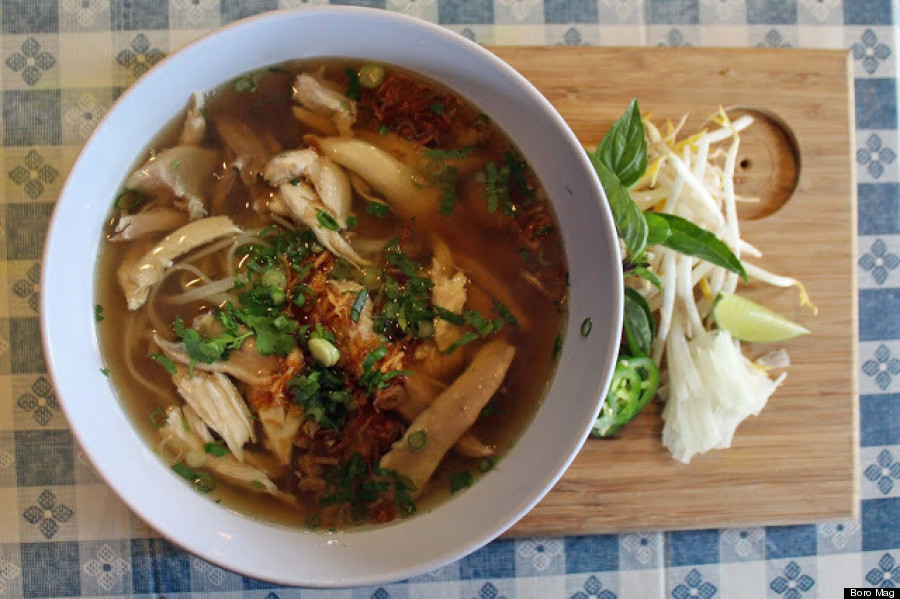 Bun-Ker Vietnamese's Phở GàPhoto credit: Boro Mag
Bun-Ker Vietnamese's Phở GàPhoto credit: Boro Mag
Tu also said bún riêu, a pork-based broth with tomatoes, crab and egg dumplings, is "not represented properly, [although it's a] really delicious dish." Another chef, An Nguyen Xuan, who owns and cooks at Williamsburg's Bep restaurant, likes bún riêu too. Xuan is also a big fan of hủ tiếu mì: what he calls a "cousin of phở, made with pork broth and shrimp." All of these soups are just the tip of the iceberg, of course.
It's not just the dominating presence of street food in Vietnam that distinguishes Vietnamese and American street food culture. Nor is it simply the sheer quantity of soups available on the street there that would be hard to find in a restaurant let alone on the street in the U.S. It's also the way people consume street food. Instead of eating on the move, Vietnamese people sit down on these ubiquitous plastic stools and actually take a break to eat. Eating noodle soup would be difficult on the go, of course.
Could soup ever become a street food in the United States? Marco Canora, the chef behind the broth trend, seems to think so. At Brodo in New York City, he sells broth in coffee cups for people to drink on the go, at any time of day. Canora knows his customers, however, and knows how to sell and market his product in a way that will reach Americans. Brodo's incredible success confirms Canora clearly knows what he's doing. Shortly after Brodo's debut, "broth is the new juice" became every media outlet's favorite refrain, to-go bone broth surfaced in San Francisco at Belcampo Meat Co, and even Panera tried to commandeer the both trend. Canora markets his broth not as soup but as a "hot beverage" to drink any time of day, which is reiterated by the fact that he sells it in coffee cups. While Brodo doesn't open until noon, Canora told me that he'd open the shop earlier if he could. As of now, he can't make enough broth to open any earlier, but his idea is to encourage people to drink broth morning, noon and night. He also wisely pointed out that, "It's one thing to ask people to rethink their afternoon [beverage], and another thing to rethink their morning caffeine habit." Canora's conscious strategy isn't only garnering buzz. People are flocking to Brodo, and "the vast majority" of them are buying the broth in to-go cups, Canora said. Only about 20 to 25 percent buy the stuff in bulk to eat at home. While Canora may be redefining how Americans think of broth, turning it into a street food in the process, it's still miles away from the bone broth-based soups of Vietnam. Namely, Brodo's broth is portable, while Vietnamese noodle soups are not.
Americans love street food. If anybody thought that food trucks were just a passing trend, they've been proven very wrong. Americans, however, do street food very differently than Vietnamese people. On a daily basis, Americans will grab a hot dog or a taco to eat on the go, shawarma or a sandwich to bring back to the office and eat at their desks. Rarely will they stop and sit at the stand from which they buy their food. They'll make an event of hitting up a street food market like Brooklyn's Smorgasburg, whose very success is a testament to Americans' affection for street-style eating. But Smorgasburg is exactly that: an event. Chef Xuan of Bep restaurant, who sets up a stand at Smorgasburg, said some people tell him eating at the food market is like being in Vietnam, where people go to one stand for one item and cooks make food to-order right in front of you, serving it right away. Ultimately, however, it's a different street culture, Xuan acknowledged. And that's the crux of the matter -- street food is inseparable from the culture in which it exists. Xuan grew up in Paris where the street food is entirely different as well. Eating anything on the street used to be frowned upon there, but with the introduction of food trucks, "now they're kind of catching up," Xuan said. Whatever form street food takes and no matter where you go, you can't take the street out of the street food.
Phở may have succeeded at becoming a mainstream soup in the U.S., but, eaten for dinner and not breakfast and in sit-down restaurants and not on the street, it looks very different than it does in Vietnam. The dish itself might be transferable across the globe, but there's an unbreakable tie between the location and the food -- the tie that turns a dish into a meal. When I think back to the morning when we ate bún cá by accident, it was the full experience -- the humid air, the tiny table and stools, the man ladling soup an arm's length away and the unfamiliarity of it all -- just as much as the food itself that made it the best meal we ate in a two monthlong trip through Southeast Asia. We may never be able to replicate the experience again, but that's the beauty of Vietnamese street food: there will always be another totally unique and extraordinary meal to be had just around the corner.
